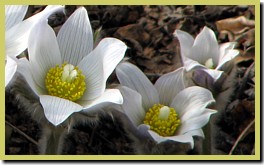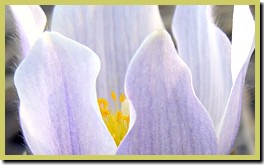
Manitoba’s Floral Emblem, our Prairie Crocus
A Visit to the Living PrairieOne of my spring rituals, you might even call it a pilgrimage, is a visit to the Living Prairie to see the crocuses. The Living Prairie Museum, on Ness Ave in Winnipeg, is an urban nature park where 12 ha of our native tall grass prairie has been preserved -- a small reminder of what the land once looked like when bison roamed freely. It always warms my heart to stroll along the trails amid last year’s brown grasses and glimpse the mauve petals and bright yellow centers of prairie crocuses staring up at me. After months of cold and snow, they truly are the harbingers of spring. It’s no wonder that the first peoples and then the pioneers had such affection for this plant. Certainly this played a role in the selection of the crocus as Manitoba’s floral emblem. It was officially declared as such in 1906, after a vote among Manitoba school children. Our prairie crocus (Anemone patens), as its scientific name implies, is really an anemone in the Ranunculaceae or Buttercup family. European settlers called this plant a crocus because of its resemblance to European crocuses, both in flower appearance and in early blooming habit. However, European crocuses (Crocus spp.) belong to the Iridaceae, the Iris family. Unfortunately, there’s still confusion between the two; it’s common to see local flower shops offering European crocuses for sale as our provincial emblem. |
||
Crocus Biology
There are advantages to flowering early in spring, but there is a down-side, too. The crocus gains the full attention of available pollinators, and its seeds ripen so early that they can be dispersed and start to grow right away. Of course, the main drawback is the potential to get caught by a late frost. Once the flowers have opened, a severe frost can damage them and eliminate seed production for that year. You can enjoy our floral emblem in your garden, but please don’t dig them up from the wild. They have deep root systems and don’t transplant well, and anywhere they still grow must be good native prairie which should always be left alone. Local nurseries can provide you with plants, and seeds can be purchased from Living Prairie Museum. You can collect your own seeds around the middle of June, but, please, not on the Living Prairie. If the seeds are grey and come off the head easily, they are ripe. Take them home and plant them immediately. Because they ripen so early, crocus seeds will take advantage of moist conditions to germinate right away. If moisture is not available, if it’s a dry June, then the seeds will harden off and go dormant. Then they must experience stratification (exposure to a period of cool moist conditions) before they will germinate. In my experience, the germination rate of newly ripened seeds is quite high, while that of over-wintered and stratified seeds will be low. |
||
Grow Your Own
Patience is also be required to see your first blooms. This is a slow growing perennial that may take 2 or 3 growing seasons to become large enough to produce a flower. But from then on, you can count on more flowers every year. My garden crocus, grown from seed and now 12 years old, regularly produces 30 to 60 blossoms a year.
Want to see some wild crocuses for yourself? Living Prairie is your best bet if you live in Winnipeg, but there’s also Little Mountain Park, and the south side of Bird’s Hill Park is another spot to look. In general, you can find crocuses throughout southwestern Manitoba, wherever there are prairie landscapes or open meadows. South facing slopes of hills are good places to look. Spruce Woods Provincial Park is a great spot for crocuses. “When?” to see crocuses can be a little dicey. On the prairies, spring comes when it comes, not according to any calendar date. Mid-April is about the earliest to start looking for crocuses. Late April to mid-May is usually prime time and there may still be some in bloom in early June. In ClosingSo, get out for a spring walk and enjoy our floral emblem, the prairie crocus.
More on the Prairie Crocus in NatureNorth: Our Prairie Crocus |
| You can help NatureNorth produce more great articles with a secure donation through PayPal. Our Google Adsense ads pay our server costs, but that's about it. To learn more follow this link: Support NatureNorth. Thank-you! | |


